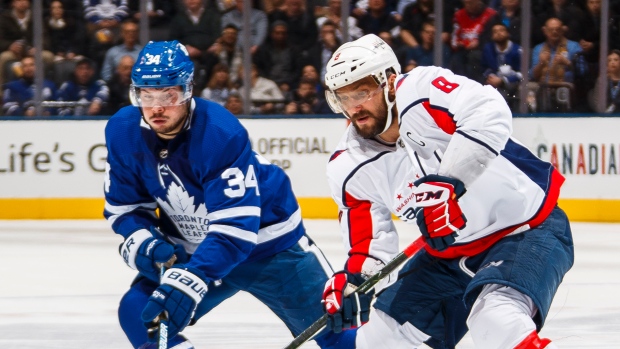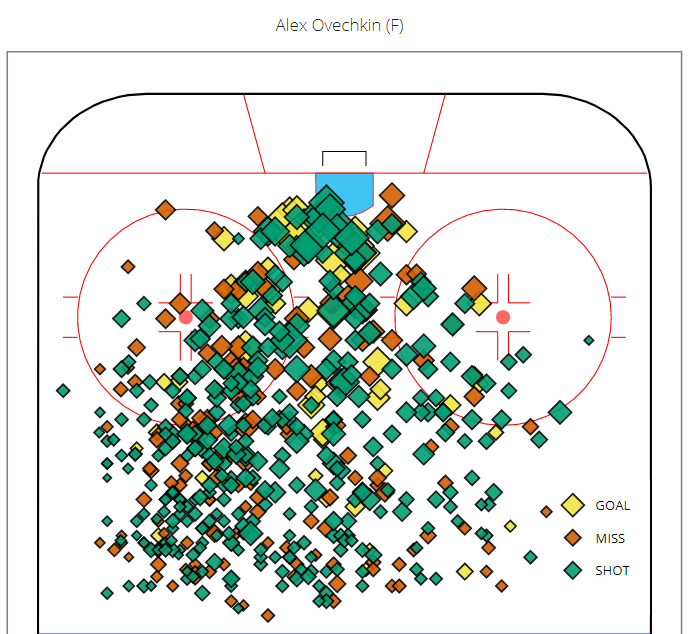May 14, 2020
Matthews appears to be following Ovechkin’s path on the power play
As he moves through his NHL career, Auston Matthews is finding more about his most efficient ways to score and it brings to mind how Alex Ovechkin discovered his bread and butter on the power play, Travis Yost writes.
By Travis Yost

Watching The Last Dance over the past few weeks has been a good reminder that no player walks right into a perfect situation.
Even superstar players – those whose talent is overwhelmingly obvious the moment they walk into a professional locker room – are relentlessly working on their craft, looking for opportunities to refine their game.
The same is true for the coaches who are gifted the opportunity to work with one of these players. Phil Jackson’s infamous installation of the triangle offence initially rubbed Chicago Bulls superstar Michael Jordan the wrong way – the ball was less frequently in his hands, and Jordan felt that was detrimental to his team’s success. But it turns out that the staple of the triangle offence – aggressive ball and player movement – threw opposing defences for a loop, and it helped the Bulls win six championships.
I think about Washington Capitals sniper Alexander Ovechkin in the same way. Ovechkin is the second-best goal scorer of all time, and has been as consistent as the sun rising and setting.
But it didn’t always make sense for Ovechkin from the jump. Remember the early days of Ovechkin, the guy who would score 50 goals without so much as blinking on those loaded Capitals teams?
He could do it in every game state, but the power play – a booming unit featuring Alexander Semin, Nicklas Backstrom, Mike Knuble and Brooks Laich – was particularly interesting.
His 2007-10 power-play shot profile was all over the place as the Capitals coaching staff was figuring out how best to use the Russian superstar:

Remember, this was peak Ovechkin – a player whose sheer athleticism, talent, and motor would win out in almost every battle.
Fast forward 10 years and we have a different Ovechkin: perhaps a step slower, but also acutely aware of what makes him dangerous. He allows his teammates to take on a bit more of a playmaking role and has turned the left circle into his own personal office.
His power-play shot profile is as predictable as they come, and yet no team has been capable of slowing him down. Look at the same graph, but from 2017-20:

That brings us to Toronto Maple Leafs star Auston Matthews. My preseason Rocket Richard Trophy pick became a two-player debate between Ovechkin and Matthews, the latter being the best candidate to unseat the eight-time winner.
My theory was that Matthews – a player obviously coming into his own as an elite offensive weapon – would have a ridiculous amount of opportunity in an otherwise loaded Toronto offence, and would benefit from being featured on one of the league’s best power-play units.
Much like Ovechkin, Matthews' shot profile on the power play has changed over time. The first three seasons of Matthews’ career saw him trying to find his spot on the ice – Matthews looking for shooting opportunities in the mid-slot, from both circles, and with a number of different linemates.
From 2016-19, Matthews – playing with a mix of William Nylander, Nazem Kadri, Leo Komarov, Mitch Marner, Connor Brown, John Tavares, and Patrick Marleau – was shooting from basically anywhere and everywhere on the ice:

Was Matthews productive with this shot profile? In one word, yes. Over this three-year window, Matthews scored 3.1 power-play goals per 60 minutes of ice time on a base of 27.4 shots per 60 minutes. That is outstanding power-play production, good enough for sixth best in the league over that span.
And yet, this season was even better. A side-to-side profile shows Matthews was taking more shots and scoring more frequently on the power play – perhaps a credit to Matthews’ evolution as a scorer, perhaps due to more consistency with his linemates.

This season, Matthews played the vast majority of his power-play minutes with Tavares, Marner and Nylander. It’s the first time Toronto’s “core four” existed together on a power-play unit with regularity, and I suspect it had an impact on Matthews’ offensive strategy up a man.
Consider his shot profile once more, but this time just for the 2019-20 season:

That certainly appears to be a very selective shooting style – one that sees him sink into the right circle and launch his howitzer of a wrist shot the same way Ovechkin does from the left circle.
For qualified skaters, Matthews finished fourth in rate scoring (12 goals total) on the power play, trailing just David Pastrnak, Mika Zibanejad, and Leon Draisaitl.
It’s hard to know if Matthews is finding his shooting preference or if he’s found his shooting preference because the team assembled the right pedigree of talent around him on the power play. In fact, both of those statements could be true. What is exciting is that one of the league’s premier scorers seems to be following in the same path as a great like Ovechkin.
And if it’s a sign of things to come? Well, I don’t think Toronto will have much to complain about.
Data via Natural Stat Trick, HockeyViz, Evolving Hockey, NHL.com

